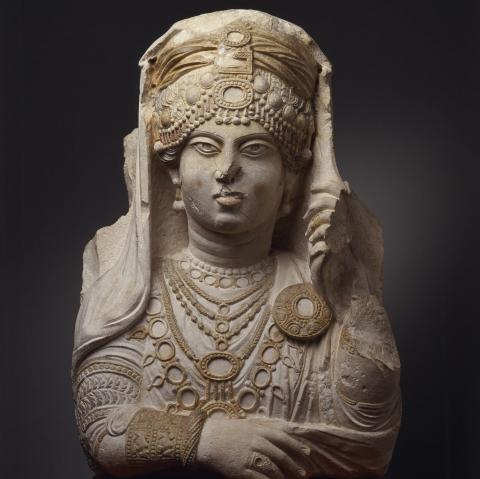The Colours of Palmyra: Ancient polychromy and the application of new natural-scientific methods
Summary of lecture by Postdoc Cecilie Brøns and Assistant professor Luise Ørsted Brandt at UrbNet, Aarhus University, 6 June 2017. Written by students Nathalia B. Kristiansen and Jesper V. Jensen.

By students Nathalia B. Kristiansen and Jesper V. Jensen.
The Palmyra Portrait Project were lucky to have both Postdoc Cecilie Brøns from Ny Carlsberg Glyptotek and Assistant Professor Luise Ørsted Brandt at UrbNet, Aarhus University give an insightful lecture on polychromy in the antiquity. Through the wonders of modern technology new methods has been used to reveal the wide array of colour on ancient artefacts such as sculpture, architectural elements etc. The focus of the lecture was on the results produced by examinations of the Beauty of Palmyra. The study of ancient polychromy is not a new field of research. Drawings from the nineteenth century show attempts to reconstruct the colouring of sculptures such as the Prima Porta, the Acropolis korai and the pediments of the Parthenon. In the 1980’s German scholars took renewed interest in the field, but it was not until recently that advances in technology allowed scholars to thoroughly investigate the both the visible as well as the invisible colour traces. The Ny Carlsberg Glyptotek is a leading institution of research on ancient polychromy with methods such UV-examination and Visual Induced Luminescence imaging (VIL). VIL is used to reveal the so called Egyptian blue, which was very widespread in the Mediterranean. The examinations of the Beauty of Palmyra showed no trace of the Egyptian blue, which is peculiar, as the colour was applied to most ancient sculptures. Egyptian blue can therefore be used to determine the authenticity of coloured ancient artifacts, however, since the Beauty of Palmyra was found on a documented excavation under the direction of Harald Ingholt, its authenticity cannot be doubted. Until recently the study of binding agents have not been a priority in the study of polychromy, however, it is now clear that binding is crucial in the process of colouring artifacts in the ancient world. These binding agents can consist of sacchaides (gum Arabic), lipids (wax), proteins (animal glue, egg yolk). Usually more than one of these was used on a single sculpture and it influenced the nuance as well as brightness. In the future, this project will be able to assist in the conservation and restauration of ancient artifacts and their colours.
The Palmyra Portrait Project were lucky to have both Postdoc Cecilie Brøns from Ny Carlsberg Glyptotek and Assistant Professor Luise Ørsted Brandt at UrbNet, Aarhus University give an insightful lecture on polychromy in the antiquity. Through the wonders of modern technology new methods has been used to reveal the wide array of colour on ancient artefacts such as sculpture, architectural elements etc. The focus of the lecture was on the results produced by examinations of the Beauty of Palmyra.
The study of ancient polychromy is not a new field of research. Drawings from the nineteenth century show attempts to reconstruct the colouring of sculptures such as the Prima Porta, the Acropolis korai and the pediments of the Parthenon. In the 1980’s German scholars took renewed interest in the field, but it was not until recently that advances in technology allowed scholars to thoroughly investigate the both the visible as well as the invisible colour traces. The Ny Carlsberg Glyptotek is a leading institution of research on ancient polychromy with methods such UV-examination and Visual Induced Luminescence imaging (VIL). VIL is used to reveal the so called Egyptian blue, which was very widespread in the Mediterranean.
The examinations of the Beauty of Palmyra showed no trace of the Egyptian blue, which is peculiar, as the colour was applied to most ancient sculptures. Egyptian blue can therefore be used to determine the authenticity of coloured ancient artifacts, however, since the Beauty of Palmyra was found on a documented excavation under the direction of Harald Ingholt, its authenticity cannot be doubted.
Until recently the study of binding agents have not been a priority in the study of polychromy, however, it is now clear that binding is crucial in the process of colouring artifacts in the ancient world. These binding agents can consist of sacchaides (gum Arabic), lipids (wax), proteins (animal glue, egg yolk). Usually more than one of these was used on a single sculpture and it influenced the nuance as well as brightness.
In the future, this project will be able to assist in the conservation and restauration of ancient artifacts and their colours.
